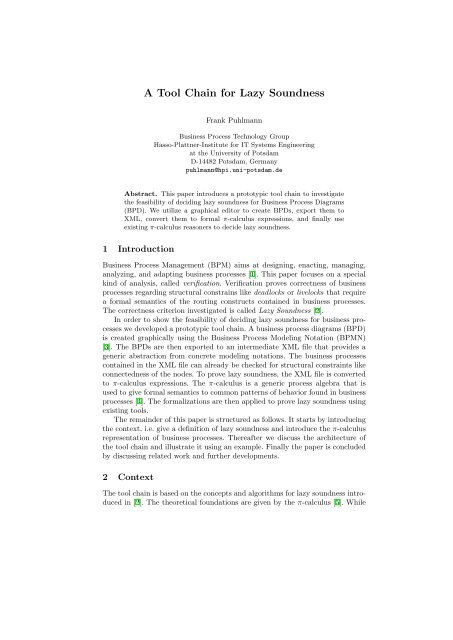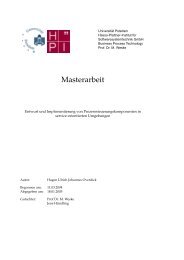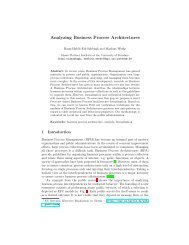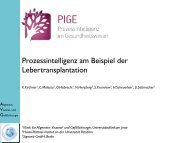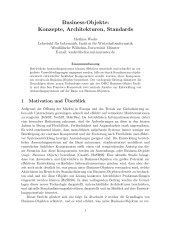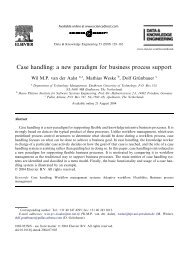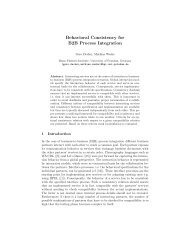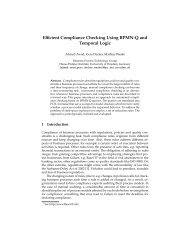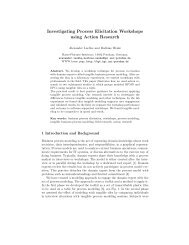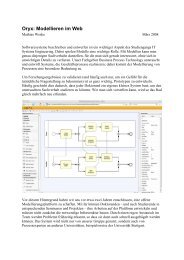A Tool Chain for Lazy Soundness - Business Process Technology ...
A Tool Chain for Lazy Soundness - Business Process Technology ...
A Tool Chain for Lazy Soundness - Business Process Technology ...
You also want an ePaper? Increase the reach of your titles
YUMPU automatically turns print PDFs into web optimized ePapers that Google loves.
A <strong>Tool</strong> <strong>Chain</strong> <strong>for</strong> <strong>Lazy</strong> <strong>Soundness</strong>Frank Puhlmann<strong>Business</strong> <strong>Process</strong> <strong>Technology</strong> GroupHasso-Plattner-Institute <strong>for</strong> IT Systems Engineeringat the University of PotsdamD-14482 Potsdam, Germanypuhlmann@hpi.uni-potsdam.deAbstract. This paper introduces a prototypic tool chain to investigatethe feasibility of deciding lazy soundness <strong>for</strong> <strong>Business</strong> <strong>Process</strong> Diagrams(BPD). We utilize a graphical editor to create BPDs, export them toXML, convert them to <strong>for</strong>mal π-calculus expressions, and finally useexisting π-calculus reasoners to decide lazy soundness.1 Introduction<strong>Business</strong> <strong>Process</strong> Management (BPM) aims at designing, enacting, managing,analyzing, and adapting business processes [1]. This paper focuses on a specialkind of analysis, called verification. Verification proves correctness of businessprocesses regarding structural constrains like deadlocks or livelocks that requirea <strong>for</strong>mal semantics of the routing constructs contained in business processes.The correctness criterion investigated is called <strong>Lazy</strong> <strong>Soundness</strong> [2].In order to show the feasibility of deciding lazy soundness <strong>for</strong> business processeswe developed a prototypic tool chain. A business process diagrams (BPD)is created graphically using the <strong>Business</strong> <strong>Process</strong> Modeling Notation (BPMN)[3]. The BPDs are then exported to an intermediate XML file that provides ageneric abstraction from concrete modeling notations. The business processescontained in the XML file can already be checked <strong>for</strong> structural constraints likeconnectedness of the nodes. To prove lazy soundness, the XML file is convertedto π-calculus expressions. The π-calculus is a generic process algebra that isused to give <strong>for</strong>mal semantics to common patterns of behavior found in businessprocesses [4]. The <strong>for</strong>malizations are then applied to prove lazy soundness usingexisting tools.The remainder of this paper is structured as follows. It starts by introducingthe context, i.e. give a definition of lazy soundness and introduce the π-calculusrepresentation of business processes. Thereafter we discuss the architecture ofthe tool chain and illustrate it using an example. Finally the paper is concludedby discussing related work and further developments.2 ContextThe tool chain is based on the concepts and algorithms <strong>for</strong> lazy soundness introducedin [2]. The theoretical foundations are given by the π-calculus [5]. While
2 Frank Puhlmannlazy soundness is a new correctness criterion <strong>for</strong> the BPM domain, the π-calculusis already in discussion as a <strong>for</strong>mal foundation <strong>for</strong> BPM [6,7]. <strong>Lazy</strong> soundness isbased on structural soundness, in<strong>for</strong>mally given by:A business process is structural sound if and only if there is (a) exactlyone initial activity, (b) exactly one final activity, and (c) all activitiesare on a path from the initial to the final activity.Furthermore, lazy soundness requires semantic reachability, meaning that anactivity B is reachable from another activity A (i.e. their exists a path betweenthem) according to the semantics of all other activities such as splits and joins.<strong>Lazy</strong> soundness is then given by:A business process is lazy sound if and only if (a) the final activity issemantically reachable from every other activity semantically reachablefrom the initial activity until the final activity has been executed, and(b) the final activity is executed exactly once.The definition states that a lazy sound business process is deadlock and livelockfree as long as the final activity has not been executed. So called lazy activitiesmight still be or become executed. Those are usually required <strong>for</strong> clean–upor subsequent activities. Examples are activities be<strong>for</strong>e a discriminator or n–out–of–m–join that has already been executed (i.e. receive remaining messagesin interacting business processes) or activities triggered by multiple–instances–without synchronization patterns [8]. In terms of Petri nets, lazy soundness supportsprocesses where tokens can remain in the net. Again, a detailed discussioncan be found in [2].A <strong>for</strong>mal semantics <strong>for</strong> business processes is given by the π-calculus. In [4,9]we have shown how different routing patterns are mapped to π-calculus expressions.Basically, each activity of a business process is mapped to a correspondingπ-calculus process. The processes then trigger themselves using a pre– and postconditionapproach. Reasoning about lazy soundness is done using weak openbisimulation. In<strong>for</strong>mally, two π-calculus processes are weak open bisimulationequivalent if they have the same observable behavior regarding certain observabilitypredicates. Weak open bisimulation can be evaluated using existing tools.3 ArchitectureFigure 1 depicts the tool dependencies and document flows in the tool chain.<strong>Tool</strong>s or scripts are shown as rectangles, whereas documents are denoted asnotes. The components developed by our group are shown inside the dottedarea.First of all, we utilize a graphical editor <strong>for</strong> designing business process diagrams.The editor is equipped with a set of BPMN stencils annotated with additionalin<strong>for</strong>mation. Based on this in<strong>for</strong>mation, an XML exporter script is ableto generate an XML description of the business process diagram by interactingwith the editor. The XML representation of the business process can already
A <strong>Tool</strong> <strong>Chain</strong> <strong>for</strong> <strong>Lazy</strong> <strong>Soundness</strong> 3GraphicalEditorXMLExporterXMLPi-CalculusConverterPiPi-Calculus<strong>Tool</strong>sStruct. Sound.CheckerBPMN StencilsFig. 1. Architecture of the tool chain.be proved to be structural sound by a structural soundness checker script. Furthermore,it can be used as input <strong>for</strong> a pi-calculus converter script that mapsthe XML file to a proprietary ASCII notation representing π-calculus processes.The implemented algorithm is described in [2]. The file containing the π-calculusprocesses can then directly be used as an input <strong>for</strong> existing π-calculus tools <strong>for</strong>reasoning.Technically, the feasibility study has been developed on Mac OS X. Omni-Graffle Professional is utilized as a graphical editor 1 , but other editors are alsopossible. OmniGraffle is fully programmable using AppleScript that was used<strong>for</strong> implementing the XML exporter. Both, OmniGraffle and AppleScript, providean easy and convenient way of designing and exporting business processdiagrams. The π-calculus converter and the structural soundness checker havebeen implemented as Ruby scripts, so they are OS–independent. The π-calculustools compatible with our scripts are MWB and ABC, the two major reasoners<strong>for</strong> π-calculus [10,11]. Both are also available on various plat<strong>for</strong>ms.4 ExampleAfter introducing the theoretical foundations and architecture of the tool chain,we are now ready to give an illustrating example. Figure 2 shows a business processstarting with a parallel split, leading to the parallel execution of activitiesA, B, and C. These activities can represent sub-processes <strong>for</strong> contacting threedifferent experts <strong>for</strong> writing an expertise. A 2–out–of–3–join continues the executionat activity D after two of them are ready. However, some cleanup workis left <strong>for</strong> the remaining activity, e.g. receiving the last expertise and payingthe expert. Activity D spawns of three multiple instances of itself, sending theaccepted expertises to three different involved persons. While the expertises arestill in delivery, the business process is already finished.The interesting point regarding lazy soundness are the lazy activities thatare left behind. This might be one of A, B, or C, as well as the three instancesof D. To prove the business process to be lazy sound, we need to export it fromour graphical editor using the XML exporter tool. The tool creates an XMLfile representing a so called process graph of the BPD. A process graph is a1 http://www.omnigroup.com/applications/omnigraffle
4 Frank PuhlmannAB2 D 3CFig. 2. Example business process diagram.mathematical structure to describe the static aspects of a business process (seealso [2]). The XML representation of the process graph looks as follows:Example 1 (XML representation of the example).Using the structural soundness checker script, the process graph contained inthe XML file can be proved to be structural sound (omitted here). The dynamicaspects of the business process are generated out of the type descriptions <strong>for</strong>each node contained in the XML file by the π-calculus converter. The <strong>for</strong>maldescription is furthermore enhanced with lazy soundness annotations as well asa special process called S LAZY used <strong>for</strong> reasoning later on:Example 2 (π-calculus representation of the example).agent N1025(e798,e799)=e798.(t.0 | t.0 | t.0 | ’e799.0 | N1025(e798,e799))agent N717(e671,e794,e792,e791)=e671.t.(’e794.0 | ’e792.0 | ’e791.0 |N717(e671,e794,e792,e791))agent N677(e791,e795)=e791.t.(’e795.0 | N677(e791,e795))agent N534(e671,i)=i.t.’e671.0agent N538(e799,o)=e799.t.’o.N538(e799,o)agent N748(e797,e796,e795,e798)=(^h,run)(N748_1(e797,e796,e795,e798,h,run) |N748_2(e797,e796,e795,e798,h,run))agent N748_1(e797,e796,e795,e798,h,run)=e797.’h.0 | e796.’h.0 | e795.’h.0agent N748_2(e797,e796,e795,e798,h,run)=h.h.’run.h.N748(e797,e796,e795,e798) |run.t.’e798.0agent N790(e794,e797)=e794.t.(’e797.0 | N790(e794,e797))agent N789(e792,e796)=e792.t.(’e796.0 | N789(e792,e796))agent N(i,o)=(^e799,e798,e797,e796,e795,e794,e792,e791,e671)(N1025(e798,e799) |
A <strong>Tool</strong> <strong>Chain</strong> <strong>for</strong> <strong>Lazy</strong> <strong>Soundness</strong> 5N717(e671,e794,e792,e791) | N677(e791,e795) | N534(e671,i) | N538(e799,o) |N748(e797,e796,e795,e798) | N790(e794,e797) | N789(e792,e796))agent S_LAZY(i,o)=i.t.’o.0The input style generated corresponds to MWB as well as ABC. Each node ofthe XML file has been mapped to a π-calculus process (denoted as agent in thesyntax). For instance, the initial node is given by N534, or the 2–out–of–3–join byN748. Helper agents are denoted with an index, like 748 1. BPMN sequence flowshave been mapped to π-calculus names, representing dependencies between theagents. For instance, N717 can only start after N534 has emitted the name e671(an agent emits a name using ′ name and receives a name by simply stating it,i.e. name). To make reasoning possible, all agents representing nodes are placedin parallel in agent N. For accuracy, the identifiers provided by the graphicaleditor are used. The generated agents can now be imported into existing π-calculus reasoners such as MWB:The Mobility Workbench(MWB’99, version 4.136, built Fri Apr 7 16:02:07 2006)1MWB>input "agents.mwb"MWB>weq N(i,o) S_LAZY(i,o)The two agents are equal.Bisimulation relation size = 317.The first statement imports the π-calculus process definitions. <strong>Lazy</strong> soundnesscan now be decided using weak open bisimulation between process N(i, o)and S LAZY (i, o). The parameters i and o can be observed <strong>for</strong> deciding whetherthe business process is started (by observing i) or the final activity is reached(by o). If o is not observed exactly once, the process is not lazy sound. S LAZY isalready proved to be lazy sound, since it simply receives i one time and emits oone time. The weq statement now checks if N(i, o) equals S LAZY regarding theobservable behavior. As both are equal, also N(i, o) is lazy sound. Interestingly,components of N(i, o) representing lazy activities are still active. However, theydo not trigger the final activity (the one that emits o) again.A counterexample can be given by modifying the parallel split of figure 2 toan exclusive decision. This results in a change of agent N717 of the π-calculusrepresentation:agent N717(e671,e794,e792,e791)=e671.t.(’e794.N717(e671,e794,e792,e791) +’e792.N717(e671,e794,e792,e791) + ’e791.N717(e671,e794,e792,e791))Now, either activity A, B, or C are activated. As can easily be deduced, thisleads to a deadlock since the 2–out–of–3–join expects at least two activities tobe finished be<strong>for</strong>ehand. By asking MWB using the changed agent N717 this canbe proved:MWB>weq N(i,o) S_LAZY(i,o)The two agents are NOT equal.Hence, the modified business process is not lazy sound.Drawbacks. During early experiments using MWB and ABC <strong>for</strong> deciding lazysoundness of different business processes, we already discovered several issues.First of all, weak open bisimulation is undecidable in general. Thus, some inputswill not give a result. To make matters worse, current implementations of MWBand ABC rely on depth first search, wasting computing power where breadth
6 Frank Puhlmannfirst search would already disprove lazy soundness (i.e. finding other paths thatlead to deadlocks and livelocks). However, small to mid-size processes can beproved in reasonable time (see [2] <strong>for</strong> timing results). Furthermore, due to thenon–local semantics of the synchronizing merge pattern (or–join), business processescontaining this pattern are never lazy sound. As a concluding remark, alsobacktracking of errors found in the π-calculus representation to the graphical notationis currently quite difficult. Using optimized reasoners and enhancing theπ-calculus representation with additional debugging in<strong>for</strong>mation, most of theproblems can be solved.5 Related WorkAn important piece of related work is Woflan (http://is.tm.tue.nl/research/woflan.htm). Woflan is able to prove if two Petri nets are in a certain inheritancerelation [12]. Most interesting is checking <strong>for</strong> projection inheritance, thathas been derived from process algebra [13]. An in<strong>for</strong>mal description is as follows:”If it is not possible to distinguish the behaviors of x and y [x and y arePetri nets] when arbitrary tasks of x are executed, but only the effectsof tasks that are also present in y are considered, then x is a subclass ofy.” [12].Hence, y represents the S LAZY process and x an arbitrary Petri net to check<strong>for</strong> con<strong>for</strong>mance. S LAZY is given as a Petri net consisting of two places and atransition t:tThe transition t can be enhanced with arbitrary process structures. Since projectioninheritance ignores remaining tokens in the Petri net, lazy soundness <strong>for</strong>Petri nets can be proved using Woflan. However, just as with ABC and MWB <strong>for</strong>π-calculus, the only feedback is a yes/no answer. Furthermore, using Petri nets<strong>for</strong> proving business processes to be lazy sound has two major drawbacks. Firstof all, not all workflow patterns can be represented in low-level Petri nets [14].Thus, the number of possible business processes is restricted. Second, branchingbisimilarity used <strong>for</strong> projection inheritance does not take into account linkpassing mobility. Link passing mobility is used inside service oriented architecturesto represent dynamic binding of interaction partners [9]. Since weak openbisimulation supports link passing mobility, lazy soundness can be extended tointeraction soundness. Interaction soundness proves an orchestration to be (lazy)sound regarding also its interactions inside a choreography. Since not all of theinteraction partners are statically known (i.e. connected) to the orchestration atdesign–time, but instead are bound at run–time, a bisimulation technique basedon link passing mobility is required.
A <strong>Tool</strong> <strong>Chain</strong> <strong>for</strong> <strong>Lazy</strong> <strong>Soundness</strong> 76 ConclusionIn this paper we introduced a first prototypic tool chain to show the feasibilityof deciding lazy soundness using π-calculus. In order to evaluate the tool chain,the scripts and examples are provided at http://pi-workflow.org. While thegraphical editing and export is currently OS depended (Mac OSX 10.4 required),the conversion of the examples to π-calculus and reasoning runs on a variety ofplat<strong>for</strong>ms. The very next step regarding the tool chain is to create a stableimplementation. This implementation can then be used to analyze existing π-calculus tools as well as the proposed pattern <strong>for</strong>malizations <strong>for</strong> con<strong>for</strong>manceregarding lazy soundness.References1. van der Aalst, W.M.P., ter Hofstede, A.H., Weske, M.: <strong>Business</strong> <strong>Process</strong> Management:A Survey. In van der Aalst, W.M.P., ter Hofstede, A.H., Weske, M., eds.:Proceedings of the 1st International Conference on <strong>Business</strong> <strong>Process</strong> Management,volume 2678 of LNCS, Berlin, Springer-Verlag (2003) 1–122. Puhlmann, F., Weske, M.: Investigations on <strong>Soundness</strong> Regarding <strong>Lazy</strong> Activities.In Dustdar, S., Fiadeiro, J., Sheth, A., eds.: Proceedings of the 4th InternationalConference on <strong>Business</strong> <strong>Process</strong> Management (BPM 2006), volume 4102 of LNCS,Berlin, Springer Verlag (2006) 145–1603. BPMI.org: <strong>Business</strong> <strong>Process</strong> Modeling Notation. 1.0 edn. (2004)4. Puhlmann, F., Weske, M.: Using the Pi-Calculus <strong>for</strong> Formalizing Workflow Patterns.In van der Aalst, W., Benatallah, B., Casati, F., eds.: Proceedings of the3rd International Conference on <strong>Business</strong> <strong>Process</strong> Management, volume 3649 ofLNCS, Berlin, Springer-Verlag (2005) 153–1685. Milner, R., Parrow, J., Walker, D.: A Calculus of Mobile <strong>Process</strong>es, Part I/II.In<strong>for</strong>mation and Computation 100 (1992) 1–776. Smith, H., Fingar, P.: <strong>Business</strong> <strong>Process</strong> Management – The Third Wave. Meghan-Kiffer Press, Tampa (2002)7. Puhlmann, F.: Why do we actually need the Pi-Calculus <strong>for</strong> <strong>Business</strong> <strong>Process</strong>Management? In Abramowicz, W., Mayr, H., eds.: 9th International Conference on<strong>Business</strong> In<strong>for</strong>mation Systems (BIS 2006), volume P-85 of LNI, Bonn, Gesellschaftfür In<strong>for</strong>matik (2006) 77–898. van der Aalst, W.M.P., ter Hofstede, A.H.M., Kiepuszewski, B., Barros, A.: WorkflowPatterns. Technical Report BETA Working Paper Series, WP 47, EindhovenUniversity of <strong>Technology</strong> (2000)9. Overdick, H., Puhlmann, F., Weske, M.: Towards a Formal Model <strong>for</strong> Agile ServiceDiscovery and Integration. In Verma, K., Sheth, A., Zaremba, M., Bussler, C., eds.:Proceedings of the International Workshop on Dynamic Web <strong>Process</strong>es (DWP2005). IBM technical report RC23822, Amsterdam (2005)10. Briais, S.: ABC Bisimulation Checker. Available at: http://lamp.epfl.ch/∼ sbriais/abc/abc.html (2003)11. Victor, B., Moller, F., Dam, M., Eriksson, L.H.: The Mobility Workbench. Availableat: http://www.it.uu.se/research/group/mobility/mwb (2005)12. van der Aalst, W., Basten, T.: Inheritance of Workflows: An approach to tacklingproblems related to change. Computing science reports 99/06, EindhovenUniversity of <strong>Technology</strong>, Eindhoven (1999)
8 Frank Puhlmann13. Basten, T.: In Terms of Nets: System Design with Petri Nets and <strong>Process</strong> Algebra.PhD thesis, Eindhoven University of <strong>Technology</strong>, Eindhoven, The Netherlands(1998)14. van der Aalst, W.M.P., ter Hofstede, A.H.M.: YAWL: Yet Another Workflow Language(Revised version. Technical Report FIT-TR-2003-04, Queensland Universityof <strong>Technology</strong>, Brisbane (2003)


